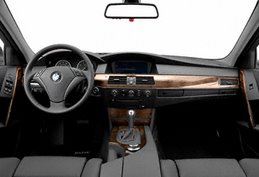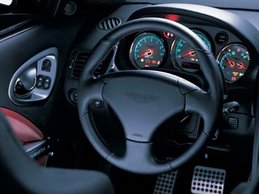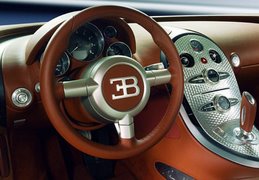 2007 Cadillac Escalade - Looks like mission accomplished to us. Check the bigger grille, inspired, according to the divisional publicity mill, by the Cadillac Sixteen show car of 2003. Check the “tri-element headlamps,” with their high-intensity-discharge lights. Check the “front fender vent ports,” which neither vent nor port. Check the “layers of chrome accents.” Check the optional 22-inch chrome alloy wheels. Got bling? Oh, yeah.
2007 Cadillac Escalade - Looks like mission accomplished to us. Check the bigger grille, inspired, according to the divisional publicity mill, by the Cadillac Sixteen show car of 2003. Check the “tri-element headlamps,” with their high-intensity-discharge lights. Check the “front fender vent ports,” which neither vent nor port. Check the “layers of chrome accents.” Check the optional 22-inch chrome alloy wheels. Got bling? Oh, yeah.Of course, Cadillac wants us to look past any perception of pandering to the 15-minutes-of-fame folks and look at vehicle virtues. Of which there are many — for a vehicle of this type. The foundation, for example, is the new GMT900 full-size SUV and truck platform, a whole order of magnitude stiffer than its predecessor — 49 percent improved in torsional rigidity, according to Cadillac. That sounds like the difference between linguine al dente and the Brooklyn Bridge, but a little time at the big Caddy’s helm does seem to vindicate this assertion.
The chassis and suspension enhancements are easier to appreciate in the realm of ride quality. Cadillac publicity materials refer to this trait as an “unwavering ride,” which conjures up some intriguing images. Let’s say taut but supple, with less of the up-and-down motion of the previous generation, which adds up to a stronger sense of control. The Escalade irons out unruly patches of pavement without resorting to the mushy suspension tuning that still afflicts so many big SUVs, and the steering actually lets the driver know what’s going on, a welcome improvement on the overly assisted recirculating-ball system previously employed.
The most tangible dynamic upgrade, though, is one that will be the easiest for customers to appreciate, simply
 by tramping on the gas pedal. The previous Escalade offered two V-8 engine choices: a 285-hp, 5.3-liter edition in the rear-drive model, and a 6.0-liter version rated for 345 horsepower and 380 pound-feet of torque.
by tramping on the gas pedal. The previous Escalade offered two V-8 engine choices: a 285-hp, 5.3-liter edition in the rear-drive model, and a 6.0-liter version rated for 345 horsepower and 380 pound-feet of torque.Better still, the bigger, lighter engine (the previous Escalade eights had iron blocks) is paired with a new six-speed automatic transmission (6L80), a vast improvement on the previous four-speeds. It also includes a manumatic function that allows the driver to shift for him- or herself, although that sporty touch seems superfluous in a vehicle weighing almost three tons. But never mind.
Although it has slightly higher power ratings than the version of the engine used by GMC (plus 23 horsepower), our tester was a tick slower to 60 mph than the Yukon Denali we put through its paces last month, a disparity we ascribe in part to the Escalade’s slightly higher mass (5793 pounds versus 5610) and green engine — there were fewer than 200 miles on the odo when the Escalade showed up at Hogback Square.
So, improved dynamics and all-around hustle. But aside from vigorous throttle response, and that unmistakable face, the update elements that will matter most to buyers are inside. And we think what they’ll see will make them happy. The biggest single improvement is the instrument panel, which not only looks thoroughly contemporary but, at least as important, has also been moved forward and down, opening up sightlines and expanding the sense of cockpit roominess.
On the other hand, there’s more cargo space behind the rearmost seats, and the second-row seatbacks have a power-fold feature that makes it easier to load stuff or expedite entry to the third row. And getting at the post-third-row storage is easier, thanks to the power liftgate. Power-assisted elements like these may sound a little hedonistic, but like ATM cards, they’re features that make you wonder how you managed to exist before they were invented. Besides, hedonism is part of the deal here.
There are other goodies — remote starting, rear parking assist, a heated-steering-wheel option. Still, we have questions. For example, where’s the one-touch-up power-window feature? Why has GM failed to figure out a way to install a dead pedal in its large SUVs? Where’s the steering-wheel telescoping feature? Why is the tilt feature manual rather than powered? Why is the ignition switch still set into the steering column, when there’s no col
 umn lock? Why isn’t there an entry-assist handle for the driver? Why does this pricey SUV have a heavy, removable third row that folds, but not flat, instead occupying a lot of space? The six-speed is a smoothie, but will it be worth the diminished towing capacity — 7400 pounds versus a max of 8100 for the previous incarnation — to people who drag big trailer boats across the landscape?
umn lock? Why isn’t there an entry-assist handle for the driver? Why does this pricey SUV have a heavy, removable third row that folds, but not flat, instead occupying a lot of space? The six-speed is a smoothie, but will it be worth the diminished towing capacity — 7400 pounds versus a max of 8100 for the previous incarnation — to people who drag big trailer boats across the landscape?Still, there’s no question that this is a better Escalade. And pending a head-to-head confrontation, there’s no question — in our minds, at least — that the new Escalade visually upstages the Lincoln Navigator due in showrooms this fall. In fact, the folks at Cadillac see the Lexus LX470, Mercedes GL-class, and Infiniti QX56 as stronger competition.













No comments:
Post a Comment